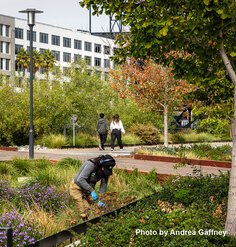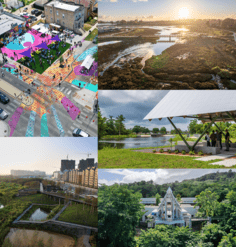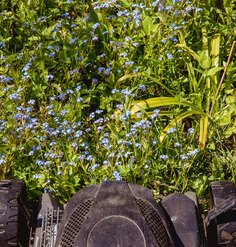From the Field: Balancing Water Conservation and Human Comfort in an Arid Region
By Kaylee Colter, MS Candidate in Applied Biological Sciences and Chris Martin, Ph.D., Professor, School of Letters and Sciences, Arizona State University
A successfully-designed sustainable landscape responds to the particular objectives and constraints of a given project site. This summer, our Case Study Investigation (CSI) team evaluated three projects in arid regions where the primary regional concerns are extreme temperatures and limited availability of water. Due to the nature of these projects being publicly accessible (and publicly funded), it was particularly important for each project to create an enjoyable public space while being thoughtful about conserving resources.
Each project struck a different balance. The Civic Space Park in Phoenix, Arizona, was designed to maximize human comfort with less emphasis on water conservation. George “Doc” Cavalliere Park in Scottsdale, Arizona, balances local park needs for human comfort with water conservation, and the Domenici Courthouse in Albuquerque, New Mexico, was designed with water conservation as its highest priority. From our studies of these three unique projects, it became apparent that trade-offs are sometimes necessary to optimize the delivery of ecosystem services.
Phoenix Civic Space Park
Located in the heart of downtown Phoenix, Civic Space is a 2.5-acre public park designed to provide the community with a vibrant amenity within a high-density urban core. For the design team, the primary goal was microclimate mitigation of extreme urban desert heat. This was achieved by providing shade structures, large shade trees, and expansive turf grass lawns. Our investigations this summer included several different studies of park temperature patterns and the surrounding area. Shaded surfaces in the park at mid-day were an average of 12.7°F cooler than those without cover. While temperatures under shade were significantly lower than those without shade, our data also showed that turf grass lawns were also highly effective at providing cooler temperatures. The Park’s lawn areas were consistently an average of 25°F cooler during mid-day and at night than paved surfaces.
Large shade trees and turf grass lawns mitigate urban microclimates by high rates of evapotranspiration, and in arid regions require extensive irrigation. The design team considered strategies for reducing the park’s potable water use but found that the amount of water that could be collected by a rainwater harvesting system would only satisfy a small percentage of the landscape’s annual water demand, and in the end did not justify the cost of its installation and maintenance.
George “Doc” Cavalliere Park
George “Doc” Cavalliere Park is a 34-acre public park tucked into the Sonoran Desert terrain of Scottsdale, Arizona. With several acres of undisturbed desert habitat on site it was important for the park to embrace the surrounding native desert habitat while also providing traditional park amenities that neighbors were eager to use. The initial design strategy was to consolidate the amenities by providing comfort with a large shade structure and limiting turf to two strategically-placed lawns.
During the park’s construction phase, however, it became apparent that the cost to maintain the two turf lawns would be a fiscal constraint for the City. The design team’s solution was to install an area of artificial turf for one lawn and delay installation of the second ‘natural’ lawn until funding was solidified. Luckily for our research team, the second turf lawn area was installed just prior to our data collection.
For most of the day, temperatures at the natural turf lawn were the coolest within the park. We also found that the cooler temperatures and availability of irrigation water runoff increased wildlife activity around the natural turf lawn.
Artificial turf, on the other hand, can become an extremely hot surface; we recorded temperatures as high as 145°F at solar noon. In fact, the City of Scottsdale added an automated sprinkler system (operating during limited hours on the weekend) to cool the artificial turf surface, and it has become a popular play feature for the park.
The playground, one of the most used features of the park, was located directly under a large shade structure, which has been highly effective at creating consistently cooler temperatures there.
Pete V. Domenici US Courthouse
Conservation of water resources was a primary sustainability goal for this sustainable landscape retrofit in Albuquerque, New Mexico. The pre-existing, turf-dominant, water-intensive landscape not only presented concerns over resource consumption but also created many technical difficulties for facility management because much of the landscape was planted over structure. Lowering landscape water demand would also reduce long-term risk for damage to the underground parking structure.
The design achieves the goal of water conservation by lowering landscape water demand and supplementing landscape water supply. The turfgrass lawn was replaced with a diverse mixture of native and drought-adapted species including, Mescal Agave, Mormon Tea, Apache Plume, Modesto Ash, Red Yucca, Pineleaf Penstemon, and Soaptree Yucca. These plants perform well when irrigated with an efficient drip system.
State regulations prevented the design team from collecting water in passive systems such as catchment basins, but they were able to collect runoff from the roof. A collection system was designed to capture water from the one-acre roof surface and store it in two underground storage tanks with a total capacity of 16,000 gallons. Due to the low water demand of the landscape, a rainwater collection system was a practical solution for this project.
Research Fellow Chris Martin and student Research Assistant Kaylee Colter are participating in LAF’s 2014 Case Study Investigation (CSI) program. They are working to evaluate and document the performance of three exemplary landscape projects in the Desert Southwest. Any opinions expressed in this article belong solely to the author. Their inclusion in this article does not reflect endorsement by LAF.











